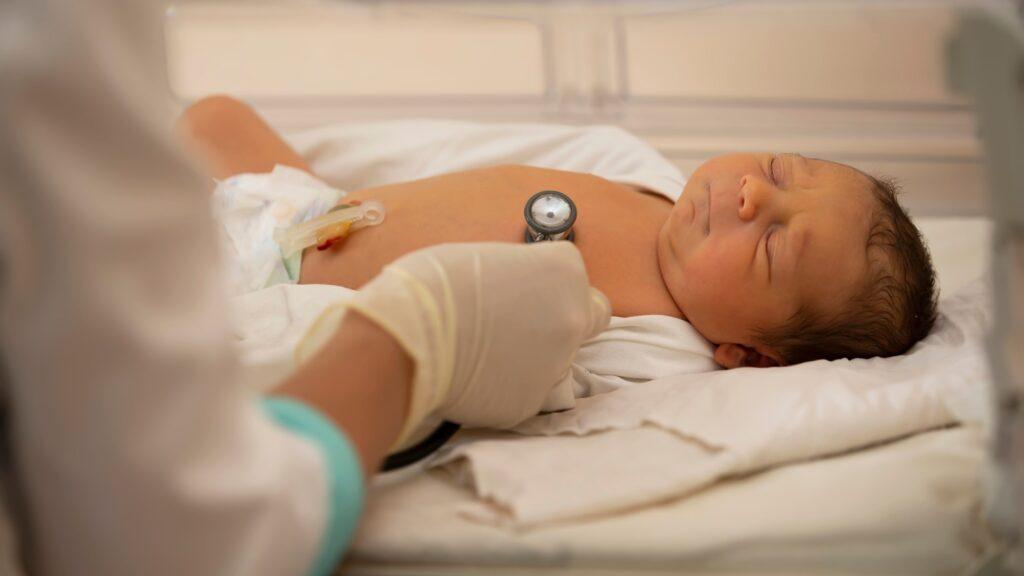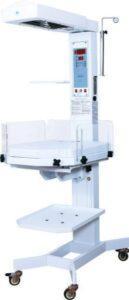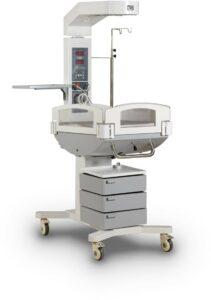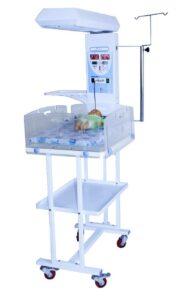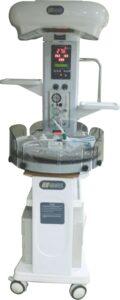A newborn’s well-being is of prime importance in neonatal care. To ensure optimal care, medical facilities rely on advanced technologies such as infant radiant warmers. These remarkable devices play a crucial role in creating a stable thermal environment for newborns, promoting their growth and development.
But before we dive into the intricacies of infant radiant warmers, let’s take a moment to introduce you to Medzell, a revolutionary B2B platform. Medzell specializes in promoting Indian medical devices in emerging markets, connecting healthcare professionals with cutting-edge technologies. With Medzell, access to innovative medical equipment, including infant radiant warmers, is just a click away. Now, let’s embark on a journey through the world of infant radiant warmers and discover how they provide optimal care for newborns.
Understanding Infant Radiant Warmers
Infant radiant warmers are essential medical devices used in neonatal care to provide a controlled and optimal thermal environment for newborns. These devices help regulate the body temperature of infants, ensuring their comfort and promoting healthy growth and development. By maintaining a consistent and appropriate temperature, radiant infant warmers create a nurturing space that mimics the conditions of the mother’s womb.
In addition to temperature control, modern infant radiant warmers offer various features to enhance neonatal care. These include adjustable heat settings, integrated monitoring systems, and safety mechanisms to prevent overheating. With easy access to the baby, healthcare professionals can provide medical interventions and routine care without compromising the infant’s warmth. Understanding the functionality and benefits of infant radiant warmers is crucial for healthcare providers and parents alike.
Open Infant Warmers
They are a popular choice in neonatal care units due to their user-friendly design and versatility. These warmers feature an open bed platform, allowing easy access to the baby while maintaining a warm and secure environment. The open design enables healthcare professionals to perform procedures, such as resuscitation and medical examinations, without the need to disturb the infant’s thermal stability.
They often come with intuitive controls, adjustable heat settings, and built-in safety features. The transparent panels surrounding the bed facilitate visual monitoring of the baby’s condition, enabling healthcare providers to keep a close eye on the newborn while maintaining an optimal thermal environment. Open infant warmers offer an ideal balance between accessibility, functionality, and comfort, making them a valuable asset in neonatal care units.
Closed Infant Warmers
Closed infant warmers provide an enclosed chamber that offers additional insulation and protection for newborns. The closed design helps prevent drafts and temperature fluctuations, creating a cocoon-like atmosphere that promotes the infant’s well-being.
When considering closed infant warmers, factors such as ease of access to the baby, ergonomics, and noise levels should be taken into account. Additionally, compatibility with other medical equipment and the ability to provide an optimal healing environment for infants with specific medical conditions should be considered.
Understanding the functionality, benefits, and considerations of closed infant warmers is essential for healthcare providers and administrators involved in neonatal care. These devices offer a reliable solution for maintaining the thermal stability required for the healthy development of newborns.
Temperature Control in Infant Radiant Warmers
Temperature control is a crucial aspect of neonatal care, and infant radiant warmers are designed to provide precise and effective regulation of body temperature for newborns. These advanced devices offer various temperature control mechanisms to ensure the optimal thermal environment for infants.
Infant radiant warmers typically feature adjustable temperature settings, allowing healthcare professionals to set the desired warmth for each baby. The temperature control system in these warmers utilizes sophisticated sensors and algorithms to monitor and regulate the heat emitted by the device.
Moreover, some infant radiant warmers incorporate feedback control systems, such as servo control, to achieve precise temperature regulation. These systems continuously monitor the infant’s body temperature and adjust the heat output accordingly. By maintaining a constant temperature, infant radiant warmers help prevent fluctuations that could lead to discomfort or thermal stress for the newborn.
Servo Control: Optimizing Heat Regulation in Warmers
Servo control is a sophisticated technology employed in infant radiant warmers to optimize heat regulation and ensure precise temperature control for newborns. This advanced system continuously monitors the infant’s body temperature and adjusts the heat output accordingly, providing a stable and comfortable thermal environment.
Servo control in infant radiant warmers works by utilizing feedback mechanisms. Sensors placed on the baby’s skin or nearby monitor the skin temperature and send signals to the control unit of the warmer. If the baby’s temperature deviates from the set range, the control unit immediately adjusts the heat output, ensuring prompt correction and minimizing temperature variations. This precise regulation helps prevent thermal stress and promotes the newborn’s well-being.
Skin Temperature Monitoring in Infant Radiant Warmers
Monitoring the skin temperature of newborns is vital for ensuring their safety and well-being while under the care of an infant radiant warmer. These devices are equipped with specialized sensors and monitoring systems that continuously measure the infant’s skin temperature, allowing healthcare professionals to make informed adjustments and maintain a stable thermal environment.
The skin temperature monitoring mechanism in infant radiant warmers typically involves placing temperature sensors on the baby’s skin surface. By monitoring the skin temperature, healthcare professionals can accurately assess whether the infant is experiencing optimal warmth or if adjustments need to be made. If the skin temperature deviates from the desired range, appropriate actions can be taken to ensure the baby’s comfort and prevent potential complications associated with overheating or chilling.
Skin temperature monitoring in infant radiant warmers often works in conjunction with the temperature control system. This integration ensures that the infant’s skin temperature remains within the desired range, promoting a stable and nurturing environment for their growth and development.
Alarm Systems in Infant Radiant Warmers
Infant radiant warmers are equipped with advanced alarm systems that play a crucial role in ensuring the safety and well-being of newborns. These alarm systems are designed to alert healthcare professionals in case of any deviations or emergencies, allowing for immediate intervention. With the ability to detect various parameters, they provide an added layer of security and help prevent potential risks. Some common alarm systems integrated into infant radiant warmers include
- Temperature Alarms: Infant body temperature alarms trigger when the body temperature exceeds or falls below a set point.
- Power Failure Alarms: In the event of a power outage or interruption, these alarms alert healthcare professionals, ensuring prompt action to restore power or transfer the infant to an alternative power source.
- Probe Displacement Alarms: When the temperature probe or other sensors become displaced or disconnected, these alarms notify the healthcare team. Prompt repositioning of the probes ensures accurate temperature monitoring.
- Apnea and Bradycardia Alarms: Some advanced infant radiant warmers are equipped with sensors to detect apnea (cessation of breathing) and bradycardia (abnormally slow heart rate). These alarms alert healthcare professionals to take immediate measures and provide necessary assistance.
Accessory Sensors: Enhancing Safety in Infant Radiant Warmers
Accessory sensors are commonly used in infant radiant warmers to enhance safety and monitoring capabilities. Here are some frequently used sensors
- Pulse Oximetry Sensors: Measure oxygen saturation in the infant’s blood, providing insights into respiratory function and well-being.
- Heart Rate Monitors: Continuously monitor the newborn’s heart rate, alerting healthcare professionals to abnormalities or changes.
- Respiratory Rate Sensors: Measure the infant’s breathing rate, detecting irregular patterns or respiratory distress.
- CO2 Sensors: Monitor carbon dioxide levels to evaluate respiratory function and ventilation adequacy.
- Weight Sensors: Provide real-time weight measurements, aiding in growth monitoring and nutrition assessment.
These accessory sensors add an extra layer of safety and monitoring, enabling healthcare professionals to assess vital parameters and make informed decisions for newborn care.
Cleaning and Sterilization of Infant Radiant Warmers
In the delicate world of neonatal care, maintaining a clean and sterile environment is paramount. By implementing these practices, healthcare facilities can minimize the risk of infections and provide optimal care for the tiniest patients.
- Regular Cleaning: Perform routine cleaning using approved mild disinfectants or cleaning agents. Wipe down surfaces, remove visible dirt or debris, and ensure the cleanliness of all components.
- Disinfection: Follow the manufacturer’s instructions for appropriate disinfectants and methods. Pay close attention to high-touch areas like control panels and handles.
- Sterilisation: Certain components, such as temperature probes or disposable items, may require sterilization. Follow the manufacturer’s guidelines for recommended sterilization methods like autoclaving or ethylene oxide sterilization.
- Proper Drying: Thoroughly dry all components after cleaning and disinfection to prevent bacterial or fungal growth. Proper drying also helps maintain the radiant warmer’s integrity and functionality.
- Regular Maintenance: Implement a maintenance schedule for routine inspections. Check electrical connections, ensure proper functioning of alarms and sensors, and address repairs or replacements promptly.
Preventive Maintenance for Infant Radiant Warmers
Preventive maintenance is essential for infant radiant warmers to ensure longevity, reliability, and optimal performance. Regular maintenance helps identify and address potential issues, reducing downtime and ensuring uninterrupted care for newborns. Key preventive maintenance practices include:
- Scheduled Inspections: Regularly inspect components, electrical systems, and mechanical parts for wear, damage, or malfunction.
- Calibration: Follow manufacturer guidelines to calibrate temperature probes and sensors for accurate readings and precise temperature control.
- Testing Alarm Systems: Periodically test temperature alarms and power failure alarms to ensure proper functioning.
- Cleaning and Lubrication: Clean and lubricate moving parts as recommended to maintain smooth operation and prevent friction.
- Documentation: Maintain detailed records of maintenance activities to track the radiant warmer’s history and ensure accountability.
- Staff Training: Provide regular training to healthcare professionals for efficient and safe operation and maintenance.
Implementing preventive maintenance practices extends the radiant warmer’s lifespan, reduces malfunctions, and promotes a reliable and safe environment for newborns.
Troubleshooting Common Issues in Infant Radiant Warmers
They occasionally encounter issues requiring troubleshooting. Here, we will explore common problems and provide practical troubleshooting techniques:
- Temperature Fluctuations: Check sensor connections, re-calibrate temperature settings, and ensure proper ventilation.
- Alarm Malfunctions: Verify alarm settings, sensor placements, and electrical connections. Reset the system if needed.
- Heat Distribution Issues: Inspect heating elements, reflectors, and airflow. Adjust the baby’s position for even heat distribution.
- Mechanical Failures: Refer to the user manual or contact technical support for malfunctioning doors, height adjustment issues, or unresponsive control panels.
- Power Supply Problems: Ensure a stable power supply, check cords and connections, and consider using a backup power source.
If you encounter persistent issues or are unsure about troubleshooting steps, consult the manufacturer’s support team or a qualified technician for professional assistance. Prompt resolution of these issues is crucial to maintain a safe and nurturing environment for newborns.
Infant Radiant Warmers from Leading Indian Manufacturers
I CORE 10
Introducing the I CORE 10 by Ibis Medical Equipment and Systems Private Limited. This infant radiant warmer from the I CORE 10 series offers a highly effective and safe solution for regulating heat in newborn babies. It’s simple design and space-efficient construction makes it ideal for neonatal intensive care units (NICU). Equipped with a microprocessor-based system, the I CORE 10 efficiently calibrates the output based on inputs from skin sensors, ensuring optimal temperature control. The user-friendly interface provides a clear view of important parameters on the control panel, and both skin and servo modes are available for precise heat regulation.
Inspiration
As a leading manufacturer in the industry, Bird Meditech offers a wide range of infant radiant heat warmers, including Inspiration. This advanced warmer is designed based on extensive industry knowledge, providing unmatched performance. The Inspiration (BMRW-97) features a user-friendly feather touch microcomputer temperature controller, a ceramic infra-red heater box, and a baby bassinet with a thick cushion mattress. Various international safety standards are met, including IEC 6061-1:1998 and IEC 601-2-21:1994. With its reliable functionality and high-quality components, Inspiration is an excellent choice for neonatal care.
IW4000 Infant Warmer
Manufactured by AVI Healthcare Pvt. Ltd., a renowned global supplier of infant radiant warmers, the IW4000 Infant Warmer is specifically designed to provide controlled warmth to neonates. This sturdy yet modern infant warmer offers both manual and servo modes of operation, ensuring optimal heat regulation. The control system, powered by microprocessor technology, guarantees precise temperature control. The IW4000 Infant Warmer is equipped with Neotherm D10 and Neotherm D20 temperature controls and features an MS construction for enhanced durability. It meets the latest EN/IEC safety standards, providing a safe and reliable solution for newborn care.
VNG-RW-900
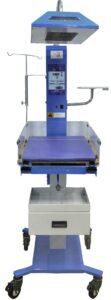
VNG Medical Innovation System Pvt. Ltd. presents the VNG-RW-900. It is an open-care infant radiant warmer designed to effectively treat newborns experiencing severe heat loss. This versatile warmer can be used in NICUs, labor rooms, and nurseries, providing quick and efficient heat regulation. It consists of a bassinet assembly, a trolley, an examination light module with a heater, and a pillar module with a controller and SMPS. The basic version includes a removable instrument tray on the pillar module for added convenience. With its reliable functionality and innovative design, the VNG-RW-900 ensures a secure environment for newborns.
Open Care System 5100/5000
Experience the Open Care System 5100/5000 by Advance Mediplus Pvt. Ltd. (AMPL). This Infant Radiant Warmer combines advanced features with resuscitation capabilities. Manufactured by AMPL, a trusted name in the industry, the Open Care System 5100/5000 offers a range of functionalities to ensure optimal care for newborns. It features a microcomputer for temperature control, a German-made ceramic infrared heater with a swiveling source box, and a thermistor-based skin/air sensor. The bright backlit LCD screen displays essential information such as alarm messages, selected mode, timer, skin temperature, and more. The Open Care System 5100/5000 also includes an integrated phototherapy unit and a removable, washable baby mattress for added convenience.
Conclusion
The use of infant radiant warmers in neonatal care units is crucial in providing newborns with optimal care. With their advanced features and functionalities, these warmers create a safe and comfortable environment for infants, promoting their well-being and development. From open infant warmers to closed ones, transport options to temperature control mechanisms, and alarm systems to accessory sensors, each component contributes to the overall effectiveness and safety of these devices. By understanding the benefits, features, and considerations of infant radiant warmers, you can make informed decisions for your medical facility or as a concerned parent.
